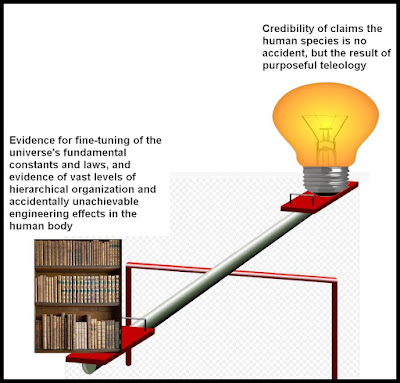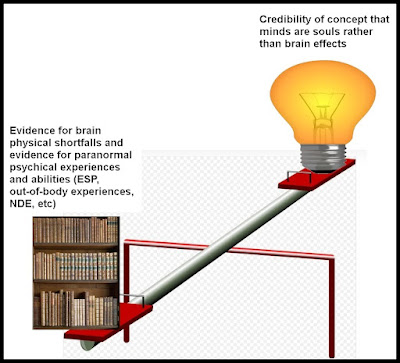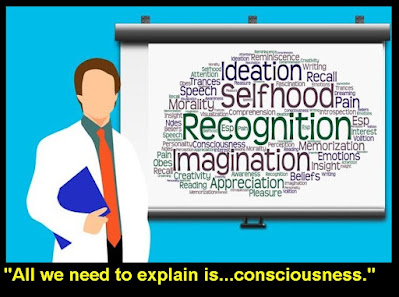Several of my previous posts have examined the unsuccessful attempts of neuroscientists to give credible answers to basic questions that might be asked by a person believing their claims that brains produce minds and that brains store memories:
- In my previous post "Exhibit A Suggesting Scientists Don't Understand How a Brain Could Store a Memory," I examined an article by a neuroscientist in The Guardian, one entitled "What happens in your brain when you make a memory?" I showed the lack of credibility in the supplied answer, which wasn't even a self-consistent one, with the author switching from a claim that memories are stored in synapses to the different claim that memories are stored in neurons.
- In my previous post "Exhibit A Suggesting Scientists Don't Understand How a Brain Could Retrieve a Memory," I looked at the answers given at an expert answers site to the question "How are memories retrieved in the brain?" In general we got the impression that none of the writers had a credible story to tell.
- In my previous post "Exhibit B Suggesting Scientists Don't Understand How a Brain Could Retrieve a Memory," I looked at the glaring inadequacies of a paper entitled "The neurobiological foundation of memory retrieval." I pointed out the authors simply ignore the whole speed problem of explaining instant memory recall. Their paper makes no mention of such a thing, and doesn't use words such as "speed" or "quick" or "fast" or "instant" or "instantaneous." The authors also ignore the issue of how a brain could decode (during memory retrieval) encoded information stored in a brain. Their paper does not use the words "decode," "decoding" or "translate." The paper merely refers in passing to some research they claim has "potentially interesting translational implications," but give no details to clarify such a claim. Nor does the paper have any discussion of some theory of a read mechanism that could be used to read memories from brains. Searching for the word "read" in the paper produces no relevant sentences.
In the same vein, let me discuss a recent article on The Conversation web site, one entitled "How Your Brain Decides What to Think." The article is written by Valerie van Mulukom, an assistant professor of cognitive science. The author gives no sign that she understands any such thing as how a brain could think or decide. All we know is that humans think things and decide things, not that brains do such a thing.
The article starts out by making an appeal to a dubious social construct, something called the "default mode network," which is not a discrete thing in the brain, and not something clearly suggested by nature, but merely some arbitrary concept invented by neuroscientists. We read this:
"How do thoughts seemingly completely unrelated to the present pop into our heads? Why do we remember certain things and not others? Why does our mind go off on tangents and why do we have daydreams? Underlying these processes is a shared pattern of common brain activity, in regions which together make up the 'default mode network', discovered and named by neurologist Marcus Raichle in the early 2000s. It’s engaged when we are daydreaming, thinking about ourselves or others, recalling memories, or imagining future events."
The "default mode network" reference is to a not very relevant or impressive paper entitled "A default mode of brain function." That paper attempted to draw conclusions based on extremely dubious brain scan studies guilty of the usual Questionable Research Practices that plague the great majority of brain scan studies, problems such as way-too-small study group sizes, and the use of misleading colorization. Figure 1 of the "A default mode of brain function" paper refers to another paper that was based on extremely dubious studies using way-too-small study group sizes (with Table 1 of that paper showing an average of only 9 subjects per study group). And so it goes in the very dysfunctional world of neuroscience: one paper drawing dubious conclusions based on some other papers that used dubious practices or shoddy research methods; and when you go through the laborious process of tracing the citations back to the original studies, you must always end up with dubious research based on things such as brain scans with way-too-small study group sizes.
Claims made that there is such a "default mode network" are criticized in the paper here, which finds such claims unsound. A paper here claiming to find signal strength changes in this "default mode network" merely finds changes no greater than 1 part in 200 (and often much less), which is unimpressive, since whenever changes so small are reported, you should suspect mere random fluctuations, mere noise that is being misinterpreted as a sign of something significant.
As for the claim made by van Mulukom that this "default mode network" is "engaged when we are daydreaming, thinking about ourselves or others, recalling memories, or imagining future events," it is contrary to the main claims originally made about such a network, such as this claim made by the previously mentioned paper: "The Default Mode Network (DMN) regions exhibit deactivation during a wide variety of resource demanding tasks." The people introducing the idea of a "default mode network" described it as a baseline or "rest mode" that could be studied when people's minds were at rest. On page 17 of the paper here, we read this claim:
"It has been repeatedly found that a set of brain structures display correlated temporal fluctuations in their hemodynamic response and the very same structures display reduced activity when any of a large number of cognitive tasks is deliberately performed. This network has been named the default mode network (DMN) (e.g., Shulman et al. 1997; Gusnard and Raichle 2001; Raichle and Snyder 2007; Buckner et al. 2008)."
But van Mulukom has strangely described this supposed "default mode network" as "engaged when we are daydreaming, thinking about ourselves or others, recalling memories, or imagining future events." This conflicts with the main way such a supposed "default mode network" has often been described. Neurons fire continuously throughout all parts of the brain. So you would never do anything to explain why a mental activity occurs by merely mentioning that some brain activity is going on in some parts of the brain while that mental activity is occurring.
What is going on with van Mulukom's answer seems to be just another example of the strategy long-used by neuroscientists, a strategy which can be described like this: when someone asks you how the brain does something, just refer to some part or subset of the brain, to make it sound like you understand the matter. A different neuroscientist gives us an example of how this works:
"Yet a minority—the clever ones—always asked a series of awkward questions. 'Where in the brain does perception occur?' 'What initiates a finger movement before cells in the motor cortex fire?' I would always dispatch their queries with a simple answer: 'That all happens in the neocortex.' Then I would skillfully change the subject or use a few obscure Latin terms that my students did not really understand but that seemed scientific enough so that my authoritative-sounding accounts temporarily satisfied them....My inability to give satisfactory answers to the legitimate questions of my smartest students has haunted me ever since. I had to wrestle with the difficulty of trying to explain something that I didn't really understand."
Next in her article van Mulukom gives us some dubious references to brain networks, referring to an "executive control network" that is not actually anything anyone has shown to exist. She says this:
"When the default mode network is engaged, other networks in the brain are down-regulated or become less active, such as the executive control network and other brain regions involved in attention, working memory, and decision-making. This is what allows the brain to wander."
This is just a claim that a brain switches around between different networks when doing different things, which doesn't amount to any explanation of how a brain could think or remember. Similarly, if you claim that your refrigerator can write essays and write computer programs, and someone asks how a refrigerator could do that, you are not giving any credible explanation if you say something like "My refrigerator switches between different electric circuits, using one circuit to write essays, and another circuit to write computer programs."
Often arbitrarily using words such as "circuit" or "network," the names neuroscientists give to particular regions of the brain reflect arbitrary social conventions and speech customs of the neuroscientist community. The wikipedia.org article on the supposed "default mode network" show no actual contiguous regions of the brain, but two areas on different sides of the brain. There is no solid rationale for calling such separated regions a network. Since the concept of the "default mode network" was introduced, claims about what it consists of and how it behaves have fluctuated very much in the neuroscience literature. If you do a Google image search for "default mode network," you will see 7 or 8 different depictions, which all disagree with each other about which parts of the brain make up such a network. A reference to so unstable and arbitrary a concept should not do anything to persuade us that van Mulukom has done anything substantial to explain how a brain could think or remember.
In the last five paragraphs of the essay, van Mulukom does nothing to suggest that she has any understanding of how a brain could produce a thought or recall a memory. We merely have five paragraphs talking about thought and memory, the kind of thing someone might write if they were trying to describe thought and memory without saying anything about a brain. There is no mention of anything specifically neural or specifically brain-related other than a passing use of the phrase "thoughts and memories brought up through the default mode network." Again, the author is using the phrase "default mode network" contrary to how that phrase was originally used in the neuroscience literature, to refer to some baseline state at which a mind is at rest, or some parts of the brain that become less active during cognitive activity.
No one can ever give any explanation of how a material thing could produce an abstract idea. We do, however, have some idea of how certain machines are able to process data in a way that some attempt to compare to thinking. Although they are incapable of conscious thought, computers can do logic and data processing by means of things such as these:
(1) a central processing unit, a small part of a computer with a unique architecture unlike any other part of the computer;
(2) an operating system, an extremely complex library of software functions of general usefulness;
(3) application programming code that follows various syntax rules so it can be executed by an interpreter or a compiler;
(4) things such as "if/then" logic, variables that store text or numbers, and programming control structures such as loops.
No such things exist in the brain. With the exception of the genetic processing apparatus that exists throughout the body, which processes only lists of amino acids in DNA, there is no place in the brain where some sequence of instructions is processed the way a computer processes sequential instructions. The brain has nothing like a computer operating system, and no application programming code. There is no place where we see "if/then" logic being processed, and we can find no place in a brain where variables store values such as numbers and text strings. We cannot detect in the brain anything like the engineering that a computer uses to process information. It has been pointed out by one expert that current neuroscience theories are not even able to explain how a brain could store a single number.
As for memories, we know from computers the kind of things a system needs for it to allow the permanent storage and instant retrieval of memories: things such as a read/write unit for writing information and reading information, a stable place allowing newly acquired information to be stably stored for decades, an encoding system capable of storing information as tokens, and a system of addressing and indexing, allowing fast retrieval of particular items of information. No person has ever found any such things in the brain. The brain has nothing we know of capable of writing memories, nothing we know of capable of reading memories, no addressing system, no sorting system, no indexes, and no known encoding system by which human learned knowledge could be translated into neural states or synapse states. It is claimed that memories are stored in synapses, but such things are very unstable, being built of proteins with an average lifetime of less than two weeks, and being connected to unstable dendritic spines that do not last for years. Closeup microscopic examination of the main structural part of synapses (synaptic terminals) shows nothing that looks anything like stored information.
The ability of humans to think, imagine, remember things for a lifetime and instantly recall rarely remembered facts is not credibly explained by brains. Claims that such things are produced by brains are speech customs parroted by a belief community that neuroscientists belong to, similar to dogmas passed down from generation to generation within some church.
Attempting to explain memory, van Mulukom has made this hesitant statement: "It’s thought that the brain stores memories in a reconstructive, associative way, storing memory details in a distributed manner and bringing them together upon retrieval – rather than in a strictly reproductive way, with video replays of whole events stored in chronological order." Instead of making it easier to explain how memories could be retrieved from a brain, this idea greatly worsens the problem.
Particular neurons in the brain are not addressable. There is no position location system or sorting system that could possibly be used by the brain to identify the exact tiny location of a stored memory. Also, humans do not at all remember any numbers associated with a storage location in the brain. I may learn the story of how George Patton led a tank army and helped liberate Bastogne during World War II, but I do not at all learn any “brain location coordinate” or location address that I associate with the name of George Patton, some neural location number that I could use to instantly retrieve the exact location of the information that I had learned about George Patton.
So if a memory or learned information is stored in some exact spot of the brain, how could your brain ever instantly find that exact spot? It seems that it could never do this, which would be like instantly finding a needle in a giant haystack. The brain would never know the exact spot to read a particular memory.
You do not at all get around this difficulty by suggesting the idea that a memory or a piece of learned information is scattered or distributed in multiple locations across the brain. The main difficulty is explaining instantaneous recall. If a brain has to search scattered storage locations in the brain, that would not be any easier than finding a single storage location; it would instead be harder. We would then have the same problem: how is it that those exact locations can instantly be found? Similarly, if a family is somewhere in New York City, and you don't know their address, without an electronic device you won't be able to find the family very quickly; and it's not going to be any easier if the family is scattered across three different apartments in different parts of the city, which would make finding the family even harder. You do not solve a "how was the needle instantly found in the haystack" problem by converting it to the even harder problem of "how were just the right few needles instantly found in multiple haystacks?" Moreover, the idea of a brain instantly bringing together scattered fragments to instantly make a unified conceptual whole creates an "instant reassembly" problem that would be an additional explanatory nightmare, with such a thing being some miracle of instant assembly as implausible as someone instantly assembling cut-up pieces of a photo after the pieces had been scattered in pages of different books on different bookshelves.
A 2022 paper makes this confession:
"We are still far from identifying the 'double helix' of memory—if one even exists. We do not have a clear idea of how long-term, specific information may be stored in the brain, into separate engrams that can be reactivated when relevant."
A recent paper on memory gives us an example of authors who can't get their story straight. First, we hear the utterly false claim that "Over the last few decades, numerous discoveries have been made regarding the properties of memory ranging from identification of the molecular mechanism(s) underlying memory formation to establishing the different temporal phases of memory." No such identification has occurred. Then we are told "the physical form of memory is elusive," a statement contradicting the previous boast. Almost all of the references in the paper are references to junk science experimental studies that did not provide good evidence for anything, because the studies were guilty of Questionable Research Practices, such as the use of way-too-small study group sizes. In a particular section we have a quote showing the authors cannot get their story straight:
"In conjunction with recent engram studies which indicate that a subpopulation of ‘engram cells’ store a given memory, it is appealing to assume that a particular memory resides in a distinct population of synapses made by axons terminating on engram cells, or by axons of engram cells onto target cells which may comprise inhibitory interneurons as well as excitatory projection targets. Engram studies remain largely at the level of the cellular engram, though there is a growing body of engram studies that are driven by and give insight into the synaptic engram."
Our authors are flip-flopping all over the place, switching between a narrative that memories are stored in cells, a narrative that memories are stored in synapses outside of cells, and a narrative that memories are stored in axons outside of cells. There is no good evidence for any of these claims. The authors sound like some husband asked why he is home very late, who says, "I was working very late at the office -- uh yeah, I'm late because I went to a baseball game, seriously, I'm home late because I went to a movie."
A 2019 paper is entitled "Where in the brain is creativity: a brief account of a wild-goose chase." We read this in the abstract:
"The neuroscientific study of creativity is stuck and lost. Having perseverated on a paradigm — divergent thinking — that is theoretically incoherent, the field has neither produced intelligible data on the brain mechanisms of creativity nor developed alternative approaches to study the topic. This paper brings into sharp focus the three confounds — validity, false category formation, compound construct — that cripple this paradigm and shows how the use of in-vogue neuroscientific concepts — right brains, prefrontal cortex, default mode network, connectivity — might have contributed to the illusion of progress in the field."
A 2022 scientific paper says, "How creative ideas arise in our mind and in our brain is a key unresolved question." A 2015 paper "The Unsolved Problems of Neuroscience" very optimistically lists the following as some of the "Problems that we should be able to solve in the next 50 years":
- What causes psychiatric and neurological illness?
- How do learning and memory work?
- How do we make decisions?
- How does the brain represent abstract ideas?







